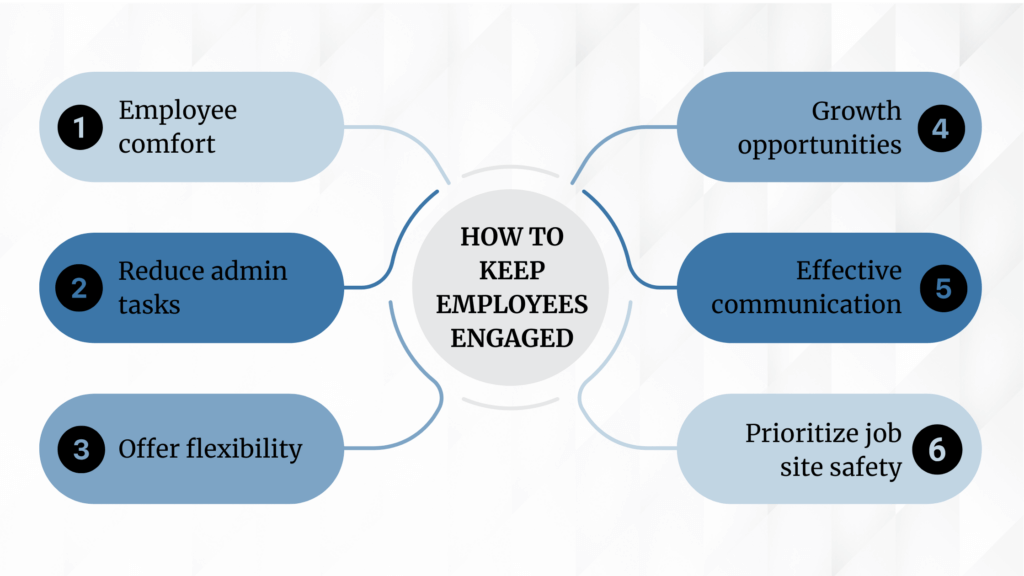Keeping construction workers engaged is the difference between a happy, productive crew and a toxic, disorganized one. Disengaged workers often feel more antagonistic and less open to feedback, and turnover could cost your company money. However, by ensuring employee comfort, offering flexible work options, providing paths for growth, and improving safety, your company could get back on track and reengage the team.
The importance of crew engagement
When your construction crew clocks in, sure, they’re there to do a job. But they’re also there to collaborate, learn, grow, and feel job satisfaction. They all have their own dreams and career goals. If companies see them solely as a means to push productivity along, it can do the opposite, or worse.
According to the EconJournals, disengaged employees are less receptive to feedback, prone to absenteeism, less productive, and overall more antagonistic. On top of that, employees who feel disengaged at work often create a culture with higher turnover, costing you money. It costs employers an estimated 33% of a worker’s salary to hire their replacement. And when workers leave, you’re also paying the price of knowledge and experience lost.
Disengagement can interfere with employee mental health, but by not trying to do better for your team, everyone loses out. Here are six simple ways to reverse the cycle of disengagement.
6 tips for keeping your construction crew engaged

1. Ensure employee comfort
Employee comfort doesn’t mean you need to paste motivational posters all over the break room. Ensuring your employees are comfortable is about fostering a genuinely positive work environment for your crew. Developing company values that reduce conflict and encourage better collaboration leads to higher job satisfaction. You can do this by:
- Organizing team-building activities: Plan a problem-solving activity, group outing, or happy hour where your team can blow off steam and have fun.
- Create an open-door policy: Establish office hours or regularly communicate that raising and discussing issues is a safe space.
- Celebrate your wins. Did your team recently complete a project or reach a new safety milestone? Celebrate with a team lunch, a round of coffee, or a small gathering. Make your team’s accomplishments appreciated.
- Prioritize health and well-being: Encourage taking personal days, offer mental health resources, and make your employees feel good about prioritizing their health.
2. Reduce administrative tasks
For some, administrative work comes with the role and can’t be changed. Some construction workers spend up to half their time on administrative tasks, such as sourcing project updates, conducting reporting, or scheduling and attending meetings. It feels like a part of the job that can’t be streamlined, and many have difficulty picturing a new way of communicating with the team. But the tedious, admin-heavy workload doesn’t have to bog down people as much as it does.
The best way to combat this is to reduce administrative burdens with construction-specific software. For example, invoicing software like Freshbooks and Zoho are explicitly designed to streamline the manual administrative work of construction professionals.
Don’t have your admin teams going about their work the manual way. Reward them with a more efficient way to work, and see both satisfaction and productivity flourish.
3. Offer flexibility
As the construction industry continues to evolve, so do the ways that work gets done. Many workers are used to long, grueling hours, with days stretching longer than necessary. This causes burnout, stress, and lower productivity.
However, job satisfaction will rise by offering a more flexible way to work, as workers have time to balance their personal and professional lives. You can provide more flexibility by:
- Offering staggered start times allows employees to avoid heavy traffic, better organize their parenting responsibilities, and better manage their personal lives.
- Offer flexible work schedules: 4-day work weeks with staggered days on/off prove to reduce burnout and boost overall morale.
- Allow workers to swap shifts with approval: Give your crew more autonomy to manage personal commitments by shift trading and working a more realistic, flexible schedule.
Flexible schedules show your crew that their time is valued on and off the job site, boosting engagement.
4. Provide growth and training opportunities
When companies invest in employee development, they encourage employees to commit to their future with the company. Everyone likes feeling that their work is valued and that they have opportunities to advance. By continuing to show that you care about that development, everyone wins.
Companies could commit to better growth and development by organizing regular workshops and seminars, training employees on new technology, and offering tuition reimbursements for training related to their roles. You could also develop a clear pathway to show employees how and when they can progress within the company. Enhancing these skills also enhances team members’ sense of purpose.
5. Promote effective communication
Employees want to feel like they’re not just a name on the schedule. For larger construction companies, it can be easy to lack empathy due to headcount—it’s a common pitfall that fosters resentment and high turnover.
To foster trust and effective communication, be transparent about business decisions and share company updates regularly. A team message can go a long way toward keeping everyone in the loop and feeling important. This message could include company status updates as well as long-term company goals and plans.
An effective way to start is by promoting communication through a collaborative tool. Many companies use a mobile-first strategy and encourage people to contact them via text on personal devices. Other companies also use communication apps with larger messaging channels to reach out to people individually and as a group.
6. Improve job site safety
Lastly and arguably most importantly, a safe team is an engaged team. The construction industry is one of the most dangerous fields, involving working high up, using heavy machinery, and handling hazardous materials.
Reaffirming that safety is a top priority makes workers feel valued, important, and more likely to take their jobs seriously. A strong safety culture also improves worker retention. Workers can promote better safety by:
- Conducting routine check-ins and audits to ensure safety plans are followed
- Host routine safety training sessions for everyone, not just new employees
- Staycurrente with the best safety training methods, like active teaching
- Celebrate safety milestones to engage workers to do their best on the job
Bottom line
Creating and fostering an engaged job site takes a conscious effort from employers and employees. Reducing administrative workload, offering flexible work options, and promoting effective communication will make your workers feel valued, satisfied, and more engaged. In turn, workers are more productive, proactive, and involved.
Don’t wait until retention becomes an issue. You can’t implement a quick fix tomorrow, but slowly rolling out these best practices will limit turnover, reduce costs, and ultimately attract more talent to the team.
Subscribe to the newsletter for more on professional development in the AEC space.



1 comment